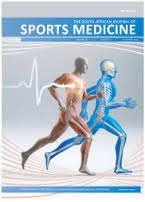An elite runner with cerebral palsy: cost of running determines athletic performance
DOI:
https://doi.org/10.17159/2078-516X/2016/v28i1a1415Abstract
Background: Running performance is widely understood in
terms of the Joyner model (VO2max, %VO2max at ventilatory
threshold (VT), running economy (often measured as cost of
running (CR) as VO2 in ml.kg‑1.km‑1).
Objective: To test the Joyner model by evaluating a runner in
whom one element of the Joyner model is systematically abnormal.
Methods: The case of a two-time Paralympian with cerebral palsy
(CP), 2nd place in the Sydney 2000 Paralympic 1500 m (T37) is
reported. Incremental and steady state treadmill runs as well as
simulated competitions were completed. Incremental and steady
state (50% PPO) cycling with two legs (2L), the non-affected leg
(NL), and the affected leg (AL) were also completed.
Results: His silver medal (2000 Sydney OG) performance for
1500 m was 269 s (4:29) (77.2% of velocity in contemporary ablebodied
world record (WR). At the time of study, his VO2max
was 64.2 ml.min‑1.kg‑1. His cost of running (CR) (1% grade) was
higher, at 257 vs 228, 211 and 188 ml.kg‑1.km‑1 (for ACSM norms,
elite Europeans, elite East Africans). During cycling, his VO2max
with 2L, NL and AL was 3.74, 3.78 and 3.71 l.min‑1, and his gross
efficiency (GE) was 18.4, 12.2 and 9.3%, respectively.
Conclusions: In a former elite runner with CP, there is little
evidence of a central oxygen transport limitation. The higher
CR (plausibly reflected by the reduced GE of his AL) appears to
account for much of the difference in performance compared to
able-bodied runners. The results provide both insight into the
physiological limitations of runners with CP and support for the
Joyner model of competitive running performance.
Keywords: biomechanics, athletic training, exercise performance,
exercise physiology
Downloads
Downloads
Published
Issue
Section
License
Copyright (c) 2016 South African Journal of Sports Medicine

This work is licensed under a Creative Commons Attribution 4.0 International License.
The South African Journal of Sports Medicine reserves copyright of the material published. The work is licensed under a Creative Commons Attribution 4.0 (CC BY 4.0) International License. Material submitted for publication in the South African Journal of Sports Medicine is accepted provided it has not been published elsewhere. The South African Journal of Sports Medicine does not hold itself responsible for statements made by the authors.
How to Cite
- Abstract 432
- PDF 542






.png)